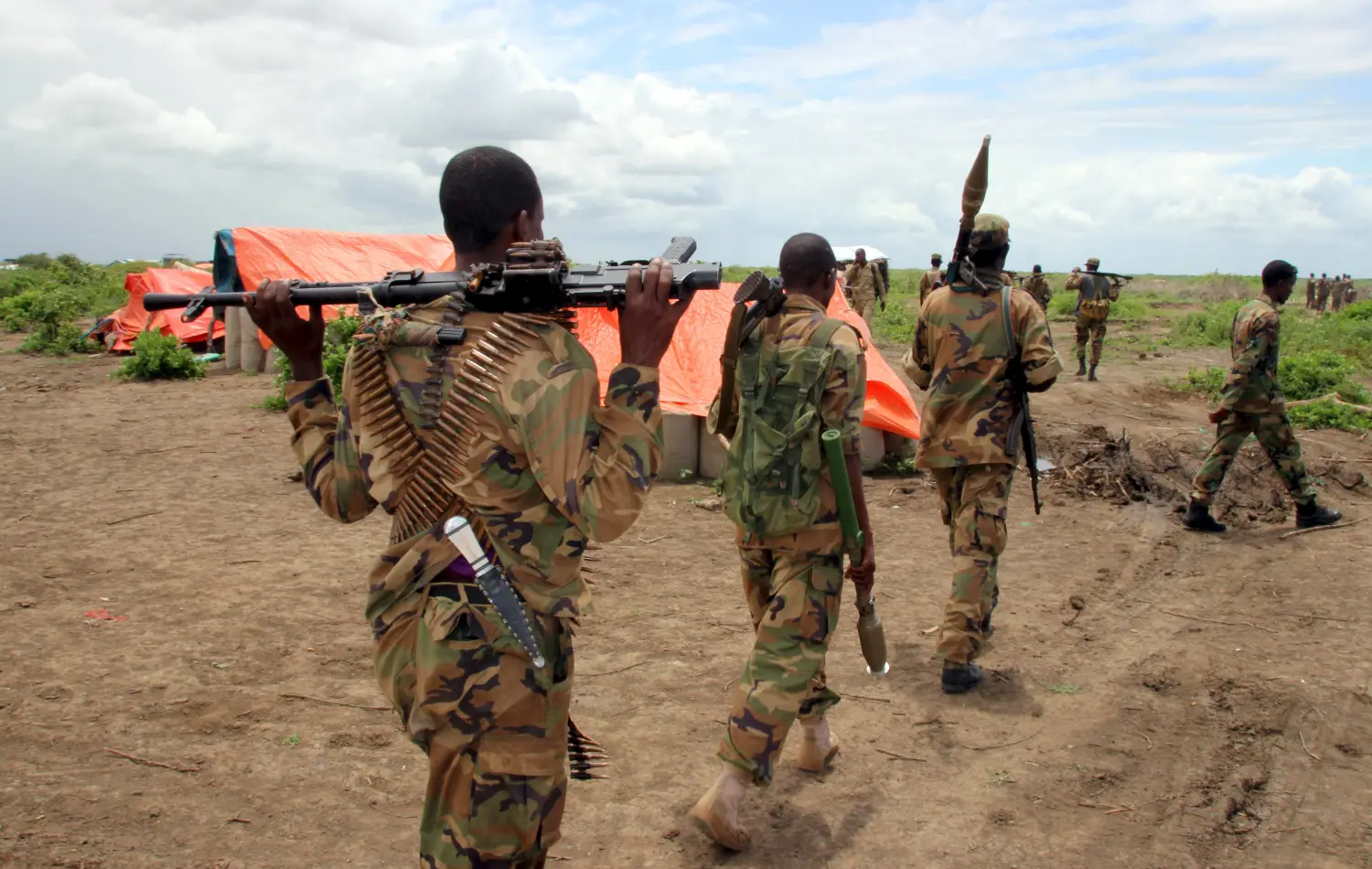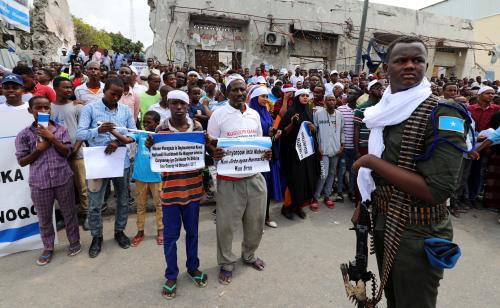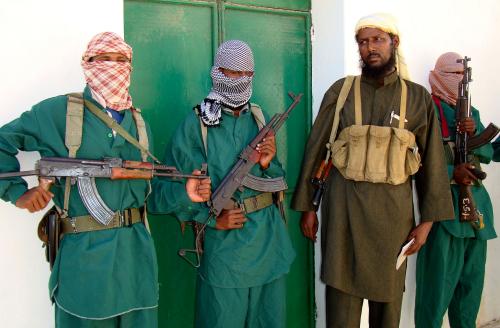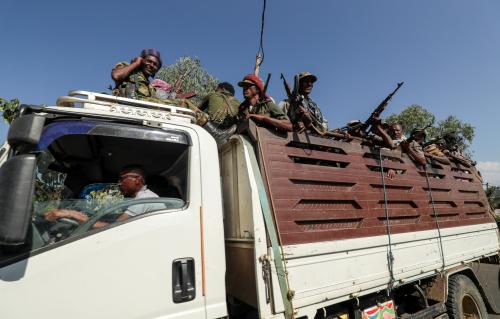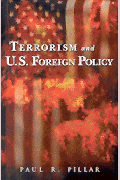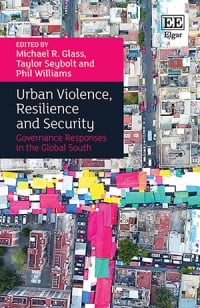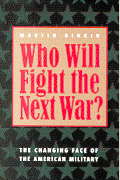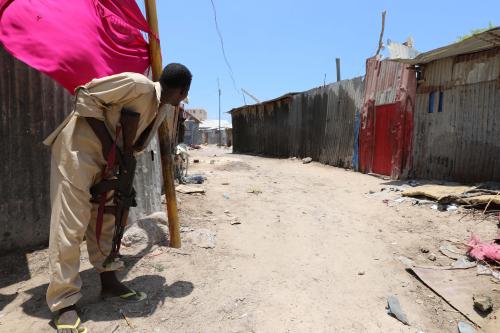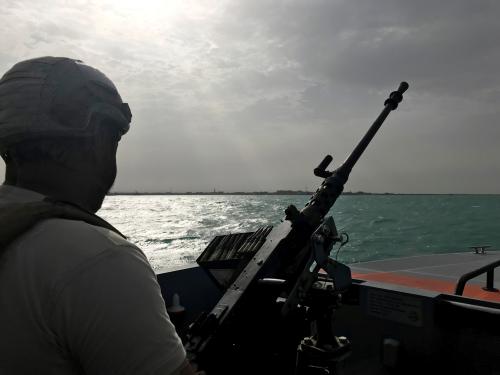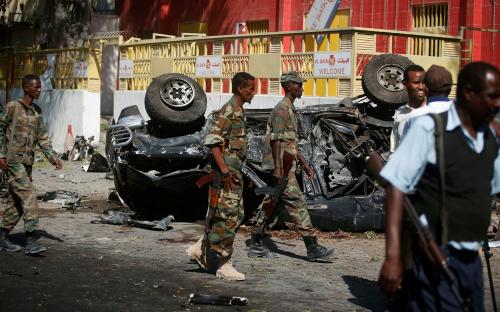The following introduction is an excerpt from the case study, “The problem with militias in Somalia: Almost everyone wants them despite their dangers,” produced by Vanda Felbab-Brown for the United Nations University report, “Hybrid conflict, hybrid peace: How militias and paramilitary groups shape post-conflict transitions,” of which Adam Day was the project lead. The full case study can be found here.
Introduction
Militia groups have historically been a defining feature of Somalia’s conflict landscape, especially since the ongoing civil war began three decades ago. Communities create or join such groups as a primary response to conditions of insecurity, vulnerability and contestation. Somali powerbrokers, subfederal authorities, the national Government and external interveners have all turned to armed groups as a primary tool for prosecuting their interests. State-aligned militias help to offset the weakness of Somalia’s official security forces, produce greater motivation and better intelligence and enhance bonds with local communities, perhaps even suppressing crime and intraclan violence.
However, Somalia’s State-aligned militia groups are also an underlying source of insecurity, violent contestation, abusive rule, impunity and pernicious outside manipulation. They give rise to and allow the entrenchment of powerful militant groups such as the Al-Qaida- supporting, jihadist Harakat al-Shabaab al-Mujahideen, commonly referred to as al-Shabaab. As such, their increasingly central role in the fight against al-Shabaab is a double-edged sword: short-term military gains must be balanced against the militias’ longer-term, destabilizing impact.
This study analyses the pros and cons of relying on militias for security provision and counter-terrorism objectives in Somalia. It details the evolution, effectiveness and effects on stabilization efforts of several militia groups — Macawiisleey, Ahlu SunnaWal Jama’a, South-West Special Police, Mukhtar Robow’s militias, Ahmed Madobe’s militias (the Jubbaland State Forces), the Puntland Maritime Police Force (PMPF) and the Puntland Security Force (PSF). The study then assesses the effectiveness and shortcomings of existing responses to militias in Somalia, providing recommendations to national actors, policymakers and practitioners.
At the beginning of 2020, militias are once again at the forefront of a major policy debate about the strategy for State-building and security in Somalia. Since 2012, after helping to dramatically weaken a brutal, dangerous al-Shabaab regime that controlled much of the country, the international community has assisted in building State institutions in Somalia, which had been overwhelmingly destroyed in two and half decades of civil war. As part of its continuing efforts to combat al-Shabaab, the international community has partnered with Somalia’s national Government to build Somalia’s official armed and law enforcement forces and civilian institutions of governance, while advancing a plan to devolve power to the country’s states (known as federal member states).
But eight years later, many of these efforts have not yet delivered results. Al-Shabaab remains one of Somalia’s most powerful political and military actors. In fact, since 2018, the group has gained momentum and deepened its political entrenchment, prompting some members of the international community to question whether the State-building model is the right approach. Despite USD $1 billion of international financial assistance and international training since 2012, the Somali National Army (SNA) continues to lack the gamut of fighting capacities, relying instead on international forces to wrest territory from al- Shabaab, or even to keep the group from openly retaking other large territories, including majorcities. Existing efforts to strengthen the SNA and other official forces are not producing adequate numbers of sufficiently competent Somali national soldiers. Intensified rivalries between Somalia’s federal Government and the federal member states further hamper the deployment and effectiveness of the SNA.
As a result, countries such as the United States, Kenya, Ethiopia and the United Arab Emirates — the former three of which have military forces in Somalia — are losing their appetite for the State-building project in Somalia.1 With the SNA chronically underperforming, these countries are poised to intensify their cultivation of pro- Government militias to fight against al-Shabaab. Even countries such as the United Kingdom and Germany (which have been at the forefront of multilateral efforts in Somalia) are increasingly motivated to support at least one set of militia groups — the State-supported paramilitary darwish (also known as “special police forces”) — through financial and possibly other non- lethal support.2 These countries’ rationale is that, although reliance on militia groups for counter-terrorism and security is problematic, it is equally unsustainable and problematic to rely on the small and incompetent SNA and the national Somali Police Force (SPF). The situation in Somalia is putting growing pressures on both the Somali Government and the international community to scale up the use of such militias.
This strategy based on auxiliary forces competes with ongoing efforts to bolster the State-building effort, including training of the official Somalinational forces (which include the national military, police and intelligence agencies), expanding a defectors’ programme for al- Shabaab and efforts to integrate at least some of demobilized militias into the official security sector.
Embracing militias carries many risks: As this study details, the loyalties of militia groups are fluid, as they are susceptible to recruitment by their enemies and may prioritize their own interests — or those of an external patron — over those of the State. Militias also divert manpower and resources from Somalia’s official forces, including by incentivizing defections. Worse still, Somalia’s militia groups, particularly without supervision or assured sustainable income, tend to engage in predatory and, at times, violent behaviour, both on rival communities and even within their own. Deeply entrenched in the political economy of Somalia, militias have strong tendencies to appropriate political authority, strengthen authoritarian forms of rule, monopolize local economies and engage in other mafia-like economic and political activities. In these ways, they exacerbate localconflicts, increase grievances and enable al- Shabaab’s political entrenchment in parts of the country. They compete with each other and, at times, with the federal Government. A poorly concluded defeat of al-Shabaab could actually plunge the country back into open fighting as the remaining militias compete for power. Foreign actors also instrumentalize Somalia’s militias, undermining Somalia’s sovereignty and entangling the country in geopolitical rivalries that could further destabilize the region.
At the same time, militias may be the best hedge against even more direct intervention by outside actors. If existing joint efforts fail to weaken al-Shabaab’s military, political and economic power, intensified bilateral interventions such as US air strikes and enlarged deployments of Ethiopian and Kenyan forces grow more likely. These forces operate outside of the mandate and framework of the African Union and the United Nations, and harken back to the troubled period of Ethiopia’s intervention in Somalia between 2006 and 2009. Other actors with substantial military assistance in Somalia, such as the Emirates and Turkey, may not be able to resist the temptation to intervene more forcefully.
Part of the risk of greater foreign intervention in Somalia arises from intensified regional and geopolitical rivalries, which shape local contestations in Somalia — and are also shaped by those local dynamics. The cold war conflict between Qatar and Turkey, on the one hand, and Saudi Arabia and the Emirates, on the other, intersects with and exacerbates conflicts and tensions between Somalia’s Government and the country’s federal member states, themselves already at a level of tension and suspicion not seen in years. For the Government, federal member states and international actors, militias are a favored tool against al-Shabaab, but their utility extends far beyond that fight. For instance, the federal member states — which carefully guard their autonomy, despite the existence of a formally agreed Somali national security infrastructure framework — see the militias as a crucial security hedge against the power of Mogadishu, Somalia’s capital. The states can use the militias as a bargaining tool in their negotiations with Mogadishu over power distribution.
Many local communities deeply distrust and resent the SNA, which they perceive as more of a conglomeration of militias than as a competent State security service. The SNA is alleged to be unreliable in delivering basic security. Rather than respond to the military chain of command, many local SNA units display greater loyalty to their own clan and community interests; they use the SNA to abuse and exploit rival clans. In response, clan elders and local communities have bolstered their own clan militias as protection — not only against al-Shabaab, but also against the SNA.
The decision to double down on pro-Government militias to address the threats posed by al- Shabaab thus risks producing new drivers of conflict while perpetuating deeply rooted intercommunal tensions. As a United Nations official in Mogadishu put it, “We have tried to get to reduced killing in Somalia without ever resolving Somalia’s conflicts.”3 And in the words of an international military advisor in Baidoa: “Fighting a war through proxies is fraught with proxy problems downstream.”4 There is growing evidence that embracing militias rewards entrepreneurs of violence, reinforces impunity, and perpetuates violence.
Nonetheless, rolling back militias in Somalia does not seem feasible at this time, given al- Shabaab’s new momentum and the lack of progress in building up the State’s capacities. Instead, policies should be adopted to reduce at least some of the most pernicious effects of militias and to mitigate their worst tendencies, even while working through and with them. Steps should be taken to hold accountable the most egregiously behaving militias. Critically, the Somali Government, the federal member states and the international community should refocus efforts on reducing local conflicts, as part of the broader strategy to combat al-Shabaab and build stronger relations between State and society.
A. Outline of this study
This study first provides an overview of the evolution and current state of the political, economic and battlefield power of al-Shabaab, alongside the capacities and deficiencies of both the various Somali national security services and the African Union Mission in Somalia (AMISOM). These dynamics take place in a fraught political context: tensions have risen between the Government and the federal member states, and there is broader geopolitical and regional competition for influence in Somalia.
The second part of the study analyses the structural and political drivers of militia formation and persistence in Somalia. It also describes the pro-militia arguments made by Somali politicians, government officials, clan elders and international actors. The second section of the study also reviews various types of militia groups in Somalia, including clan-based forces, contract militias, federal member state paramilitary darwish and militias sponsored by external actors. To understand how these militias form and operate, the study provides a detailed portrait of several prototypical militiagroups — namely, Macawiisleey, Ahlu Sunna Wal Jama’a, the South-West Special Police, Mukhtar Robow’s militias, Ahmed Madobe’s militias (the Jubbaland State Forces), the PMPF and the PSF. The section concludes with an analysis of the specific risks associated with the activities of the main militias across Somalia.
The third section of the study describes the lack of a consistent policy towards militia groups in Somalia and the increasing tendency of various international actors to embrace and bolster militias. This portion of the study explains the international community’s dilemmas in deciding how to deal with these newly strengthened forces. It reviews current and potential policies for reducing the scale and negative effects of the militias, identifying the feasibility and likely effectiveness of each. The assessed policies include:
- Integrating militias into formal security forces;
- Putting them on payroll and providing them with non-lethal assistance without integrating them into formal forces;
- Disarmament, demobilization, and reintegration (DDR);
- Addressing local conflicts as an indirect approach to eliminating the impetus for militias.
The final section of the study, on recommendations, builds on the analysis of current responses and offers concrete steps that would enable the Somali Government and international partners to limit the risks posed by militias while also benefiting from their unique capacities. The recommendations focus on the following areas:
- Avoiding or minimizing the creation of new militia groups;
- Appropriate vetting of militias prior to integration into the Somali official forces;
- Steps to end impunity for human rights violations;
- Provision of human rights and civics training;
- Establishment of a salary system for militia members integrated into the Somali national forces;
- Creation of an international payroll for some militias (for example, darwish) conditioned on a serious vetting process for human rights abuses;
- Establishment of a DDR programme
for militias, possibly accompanied by a reconsideration of the existing “ high risk defectors” programme for al-Shabaab; - Developing a strategy for al- Shabaab that prioritizes support to local conflict resolution within communities and across clans.
B. Methodology
In addition to reviewing the relevant existing literature, this study is principally based on fieldwork conducted in Mogadishu and Baidoa, Somalia, in January 2020. During that fieldwork, the author conducted 51 interviews with current and former officials of the Somali Government and the federal member states, current and former officers of Somalia’s national security forces, Somali politicians, business leaders, representatives of nongovernmental organizations (NGOs), Somali clan elders, United Nations officials, international advisors to the Somali Government and international diplomats. The study also builds on the author’s previous fieldwork in Somalia in March 2015 and December 2017.5 To protect the safety of interlocutors and to encourage them to speak honestly and openly, all interviews during this and previous fieldwork trips are reported without the use of names.
The full case study can be found here.
This material has been funded by UK aid from the UK government; however the views expressed do not necessarily reflect the UK government’s official policies.
-
Footnotes
- United Nations officials and international diplomats, interviews with the author, Mogadishu, January 2020.
- Ibid.
- Interview with the author, Mogadishu, January 2020.
- Interview with the author, Baidoa, January 2020.
- See, Vanda Felbab-Brown, “The Hard, Hot, Dusty Road to Accountability, Reconciliation, and Peace in Somalia: Amnesties, Defectors’ Programs, Traditional Justice, Informal Reconciliation Mechanisms, and Punitive Responses to al Shabaab,” in The Limits of Punishment: Transitional Justice and Violent Extremism, ed. Cale Salih (Tokyo: United Nations University, 2018), https://i.unu.edu/media/cpr.unu.edu/ attachment/3129/4-LoP-Somalia-final.pdf.

